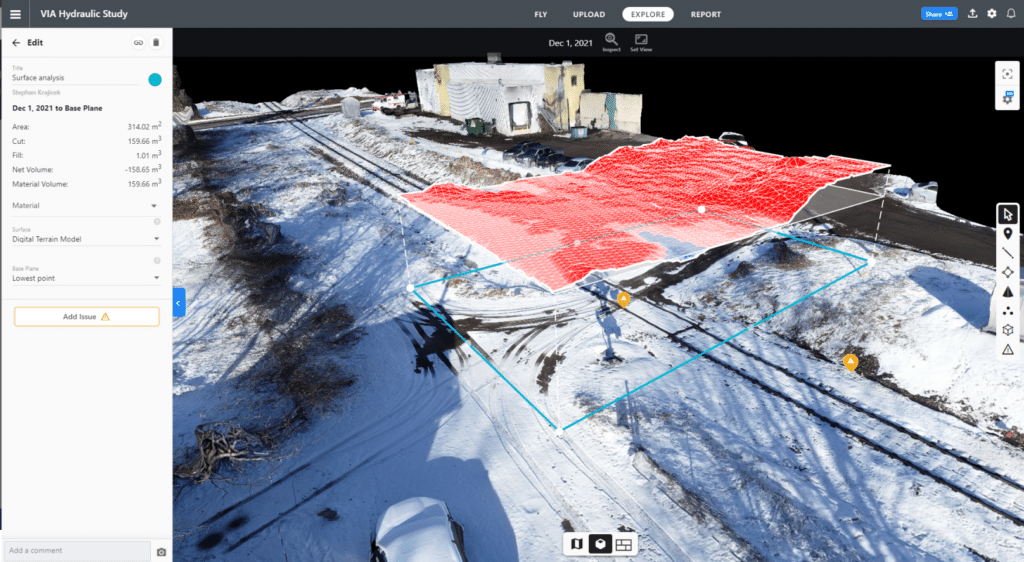Our series of articles on drones continues with another analysis by Stephan KRAJICEK, Team Leader, Mechanical Projects in SYSTRA Canada’s Rolling Stock Division. This week, he explains the benefits of using drones in railway projects. Stephan is one of the winning teams in SYSTRA’s SPARK Challenge 2022.
The railway industry has always been at the forefront of technological advancements, constantly seeking innovative ways to enhance efficiency, safety, and maintenance practices. In recent years, the integration of drones into railway operations has emerged as a game-changer, revolutionizing the industry in numerous ways. These unmanned aerial vehicles (UAVs), commonly known as drones, are proving to be invaluable tools for various tasks within the railway sector.
In this article, we will explore how drones are being utilized to improve railway operations, from infrastructure inspection and maintenance to enhancing safety and security.
Infrastructure Inspection
One of the primary applications of drones in the railway industry is infrastructure inspection. Traditional inspection methods often involve manual labor, which is time-consuming, labor-intensive, and potentially hazardous.
Drones equipped with high-resolution cameras and sensors can swiftly and safely monitor railway tracks, bridges, tunnels, and other critical infrastructure components. They can capture real-time images and videos, providing accurate data on the condition of the assets.
This enables timely detection of defects, such as cracks or wear and tear, allowing maintenance teams to proactively address issues before they escalate into safety hazards or disrupt operations.
Maintenance and Repairs
Drones have proven to be effective in streamlining maintenance and repair processes within the railway industry. Equipped with thermal imaging cameras, they can detect hotspots in electrical systems, signalling equipment, and trackside assets.
This enables maintenance crews to identify potential failures or malfunctions in advance, reducing the risk of costly breakdowns and ensuring uninterrupted operations.
Drones can also carry out routine maintenance tasks, such as cleaning or painting, with greater speed and precision than manual labor, saving time and resources.

Surveying and Mapping
Railway construction and expansion projects require accurate surveying and mapping of the terrain. Drones equipped with advanced surveying instruments, such as LiDAR (Light Detection and Ranging) sensors, can rapidly gather high-resolution data of the land, capturing detailed 3D models.
This information assists in designing new rail lines, assessing potential routes, and analyzing the impact of construction on the surrounding environment. Drones facilitate efficient data collection, reducing surveying time and costs while improving the accuracy and quality of the results.

Safety and Security
Drones play a vital role in enhancing safety and security measures within the railway industry. By deploying drones equipped with video cameras and sensors, operators can remotely monitor large areas of railway networks, identifying potential risks, trespassers, or suspicious activities.
Drones can be utilized for perimeter surveillance, detecting intrusions, and preventing unauthorized access to restricted areas. In emergency situations, such as accidents or natural disasters, drones can provide real-time aerial views to guide rescue and response teams, facilitating quick and informed decision-making.


Training and Inspections
Drone technology is also being utilized for training purposes in the railway industry. Simulated drone flights can help familiarize operators, engineers, and maintenance crews with different scenarios, enabling them to practice emergency responses, improve situational awareness, and enhance operational skills.
Additionally, drones can be used to inspect hard-to-reach areas, such as overhead electrical lines or tall structures, without the need for specialized equipment or risking personnel safety.
CONCLUSION: MAKING RAILWAY OPERATIONS MORE EFFICIENT
Drones are transforming the railway industry by providing a wide range of applications that enhance efficiency, safety, and cost-effectiveness. From infrastructure inspection and maintenance to surveying, safety, and security, these UAVs offer unparalleled advantages. By leveraging drone technology, the railway industry can optimize operations, minimize downtime, reduce maintenance costs, and improve overall performance.
As this technology continues to advance, we can expect drones to play an increasingly integral role in shaping the future of railways, ushering in a new era of innovation and productivity.
STILL TO COME…
In the next article, we will be looking at how drones are transforming the civil engineering industry.
Consult the Drones page under our Digital Solutions section to learn more.
 Australia
Australia  Brazil
Brazil  China
China  Denmark
Denmark  France
France  India
India  Indonesia
Indonesia  Ireland
Ireland  Italy
Italy  Malaysia
Malaysia  New Zealand
New Zealand  Norway
Norway  Poland
Poland  Saudi Arabia
Saudi Arabia  Singapore
Singapore  South Korea
South Korea  Sweden
Sweden  Thailand
Thailand  United Kingdom
United Kingdom  United States
United States  Taiwan
Taiwan  Vietnam
Vietnam